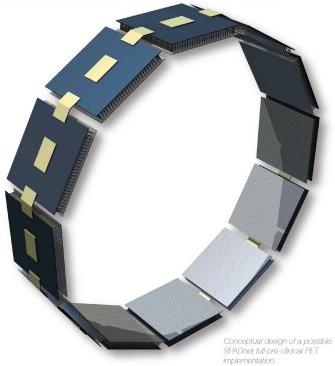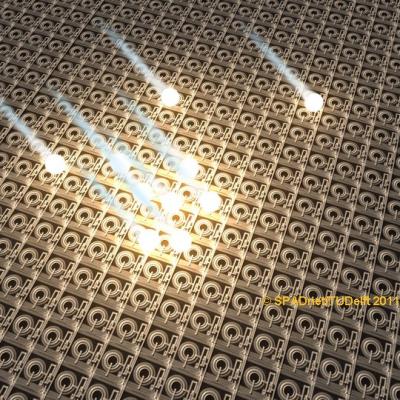Fully Networked, Digital Components for Photon-starved Biomedical Imaging Systems (SPADnet)
In this project we propose to develop a completely novel scalable, photonic component for large format, rare-event imaging. The core of the component will be a SPAD array implemented in CMOS. Large formats will be achieved by tessellating several tens of dies in abutment style using innovative packaging techniques based on through silicon vias (TSVs).
The ability to stamp the time and position of each photon impingement in a burst event offers a second key advance. We introduce the concept of spatial oversampling, where a single measurement is partitioned into a myriad of sub-measurements, occurring simultaneously. The difference is that in space oversampling many SPADs will detect the same event independently, thus reducing the dead time on average by the number of detectors involved.
The decomposition of the large format imager to a network of independent arrays is key to managing massive data streams. In conventional PMTs or SiPMs, the sensitive device produces a stream of analog electrical pulses. The photonic component proposed in this project on the contrary, generates streams of precomputed digital data.
The current state-of-the-art knowledge on inter-chip data exchange will be the basis for efficient data communication, in a true network communication style. Data packets will be routed in the network and will be handled on-demand. For example coincidence mapping engines can be used in this context as snoopers on the data bus, thus considerably simplifying systems such as PET.
THE DEVIL In THE DETAIL (short)
For more information, see the
project homepage.

Project data
| Researchers: | Edoardo Charbon, Chockalingam Veerappan, Francesco Regazzoni |
|---|---|
| Starting date: | July 2010 |
| Closing date: | December 2014 |
| Funding: | 3700 kE; related to group 500 kE |
| Sponsor: | EU FP7 |
| Partners: | EPFL (Switzerland), Budapest University of Technology and Economics (Hungary), CEA-LETI (France), University of Edinburgh (UK), Fondazione Bruno Kessler (Italy). Mediso (Hungary), STMicroelectronics (France, UK) |
| Contact: | Edoardo Charbon |